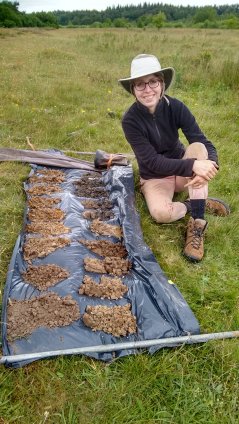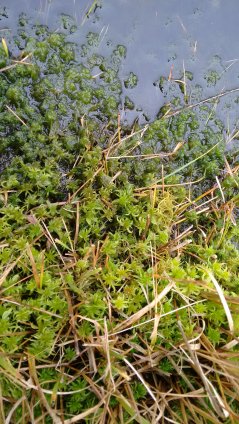
Project
Peatland initiation through time and space
Cindy Quik
Een pdf-versie van het proefschrift is beschikbaar via deze link.
A pdf-version of the PhD thesis is available through this link.
Peatlands comprise 50 – 70% of all global wetlands, making them the most prevalent wetland type. Peat deposits consist of organic material that accumulated under more or less water-saturated conditions, and form a natural archive of past environmental changes. For Europe, it is estimated that over 50% of the peatland area was lost during the twentieth century. For the Netherlands, only 1% of the former peatland area is left today. These tremendous losses in peatland surface area, and ongoing threats to their existence in Europe and elsewhere, pose the urgency to accumulate the knowledge that is contained in the peat archives, and the need to protect the areas that are left. One of the biggest changes recorded in the peat archives, the transition to peat growth itself, is underexposed in scientific research. The transition from dryland to wetland (and to peatland) represents however a huge landscape change, with major impacts for landscape functioning, ecosystem services and human-landscape interactions.


Reconstructing the period, pace and pattern of peat initiation and lateral expansion requires dating the bottom of peat deposits overlying mineral sediment, often called the basal peat. To obtain dating information for reconstructions, one can either look back in the scientific record to build on and integrate existing information, or obtain new data from the field. The huge losses of peat landscapes in Europe call for reuse of existing data, which may contain information that can no longer be obtained from the field. However, for geochronological peat research no overviews exist of factors that need to be taken into consideration for reuse of radiocarbon dates, and standardized workflows or designs for quality assessments of peat dates are lacking. When obtaining new information from the field, accurately dating basal peat is key. However, the lack of a universally applicable and quantitative definition for basal peat, combined with multiple concerns that have been raised previously regarding the radiocarbon dating of peat, may result in apparent ages that are either too old or too young for the timing of peat initiation. Furthermore, in areas where large areas of peatlands are lost, an adapted strategy is required to collect field data based on peat remnants. Alternative methods of analysis are needed to reconstruct peat initiation and lateral expansion in a way that uncertainty is quantified, which is especially relevant when reconstructing a former landscape of which large parts are lost.
In this thesis I focus on mires and peatlands that formed on non-coastal (located above mean sea level) and non-alluvial topographic plains in the coversand landscape of the temperate Northwest European mainland. The spatio-temporal development of these peatlands remains uncertain, probably as a result of their large-scale disappearance following reclamation activities in the past few centuries and consequent limited amount of data for these areas. In addition, existing information on the age of the former peatlands in the coversand landscape of the Northwest European mainland is not yet fully synthesized. I identified two key research deficits, namely (I) methodological developments are needed to constrain the spatio-temporal development of peatlands more accurately; and (II) understanding of the timing, pace and pattern of the initiation and lateral development of peatlands in the coversand landscape of the Northwest European mainland is limited, and responsible steering factors are not well understood. In this thesis I aim to reconstruct peat initiation and lateral expansion in the coversand landscape of the Northwest European mainland, and to develop the required methodological tools, which can be applied irrespective of the case study region.
Each thesis chapter (2 – 4) focuses on elements of research deficits (I) and (II). The period after the Last Glacial Maximum to the present (Late Pleniglacial and Holocene) forms the temporal scope of the thesis. The northern part of the Dutch coversand area was selected as case study region, which contains one of the largest bog remnants of the Northwest European mainland, the Fochteloërveen. This PhD-study is part of the NWO-Vidi project “Home Turf. An integrated approach to the long-term development, cultural connections and heritage management of Dutch raised bogs”, led by Roy van Beek. This project has an interdisciplinary design and consists of several interlinked project elements: landscape archaeology (by Roy van Beek), historical geography (by Maurice Paulissen), ore geology (by Aukjen Nauta), and palaeogeography (this thesis).
In Chapter 2, I developed a workflow for reuse of legacy radiocarbon dates in peatland studies, including a rigorous quality assessment that can be tailored to specific research questions and study regions. In the quality assessment, a penalty is assigned to legacy dates based on criteria that consider taphonomic quality (i.e., sample provenance) and dating quality (i.e., sample material and method used). The weights of the quality criteria may be adjusted based on the research focus, and resulting confidence levels may be used in further analyses to ensure robustness of conclusions. I applied the proposed approach to the northern Dutch coversand landscape, to synthesize existing data for this area and to gain insight in regional peat growth trends. The data search for this area yielded 313 radiocarbon dates from the 1950s to 2019. Based on the quality assessment, the dates --of highly diverse quality-- were assigned to four confidence levels. Results indicate a bimodal distribution of peat initiation and lateral expansion, with a first phase of peat growth that peaked at ~14,000 cal years BP, followed by a distinct low at approximately ~9,500 cal years BP, and a second phase that peaked at ~4,500 cal years BP. This chapter highlights the potential of legacy data for palaeogeographic reconstructions, as it is cost-efficient and provides access to information that is (partly) no longer available in the field. However, data retrieval may be challenging, and reuse of data requires that basic information on location, elevation, stratigraphy, sample and laboratory analysis are documented irrespective of the original research aims.
In Chapter 3, I provide a conceptual framework that supports the use of the organic matter (OM) gradient for a quantitative and reproducible definition of the mineral-to-peat transition (i.e., the stratigraphical range reflecting the timespan of the peat initiation process) and the layer defined as basal peat (i.e., the stratigraphical layer that is defined as the bottom of a peat deposit). I analysed the mineral-to-peat transition based on three highly detailed sequences of radiocarbon dates from cores obtained at Fochteloërveen, including dates of plant macrofossils and the humic and humin fractions obtained from bulk samples. Fochteloërveen currently harbours a bog vegetation, but biostratigraphical analyses show that during peat initiation the vegetation was mesotrophic. Results show that plant macrofossils provide the most accurate age in the mineral-to-peat transition and are therefore recommendable to use for 14C dating basal peat. If these are unattainable, the humic fraction provides the best alternative and is interpreted as a terminus-ante-quem for peat initiation. The potential large age difference between dates of plant macrofossils and humic or humin dates (up to ~1700 years between macrofossil and humic ages, and with even larger differences for humins) suggests that studies reusing existing bulk dates of basal peat should take great care in data interpretation. The potentially long timespan of the peat initiation process (with medians of ~1000, ~1300 and ~1500 years at the three studied sites) demonstrates that choices regarding sampling size and resolution need to be well substantiated. I summarise all findings as a set of recommendations for dating basal peats, and advocate the widespread use of OM determination to obtain a low-cost, quantitative and reproducible definition of basal peat that eases intercomparison of studies.
In Chapter 4, I searched for explanatory variables within a digital soil mapping approach that enables reconstructions of the pattern of peat initiation and lateral expansion within (and potentially beyond) peat remnants, with quantified uncertainty. Basal radiocarbon dates were obtained from the Fochteloërveen peat remnant, which formed the basis for subsequent analyses. I investigated the relationship between peat initiation age and three potential covariates: (1) total thickness of organic deposits, (2) elevation of the Pleistocene mineral surface that underlies the organic deposits, and (3) a constructed variable representing groundwater-fed wetness based on elevation of the mineral surface and current hydraulic head. Significant relationships were found with covariate (1) and (3), which were hence used for subsequent modelling. Results indicate simultaneous peat initiation at several loci in the Fochteloërveen during the Early Holocene, and continuous lateral expansion until 900 cal y BP. Lateral expansion accelerated between 5,500 – 3,500 cal y BP. The presented approach is spatially explicit (i.e., results in a map of peat initiation ages), and allows for a quantitative evaluation of the prediction using the standard deviation and comparison of predictions with validation points. The applied method based on covariate (1) is only useful where remnant peat survived, whereas covariate (3) may ultimately be applied to reconstruct peat initiation ages and lateral peatland expansion beyond the limits of peat remnants.
The methodological tools presented in this thesis may help to advance science on peatland reconstructions. Depending on research objectives, they can be applied separately, or concurrently in a complementary manner.
Peat initiation results from terrestrialisation, paludification and/or primary mire formation. Based on the findings of this thesis, I conclude that paludification was the most prominent process of peat formation in the northern Dutch coversand landscape (and Fochteloërveen), with local occurrence of terrestrialisation sites. The work presented in this thesis points to several environmental factors that may have led to paludification, consequent peat initiation and subsequent lateral expansion. I present a hypothesis on the steering factors for paludification and peat growth in the Northwest European mainland, that offers starting points for further research.
Increased understanding of the age and palaeogeography of peatlands is highly relevant for research on ecosystem services provided by peatlands (such as carbon dynamics), for nature conservation and restoration, and for cultural history and heritage management. Carbon dynamics form a key ecosystem service provided by peatlands. The age and spatial extent of peat deposits are crucial parameters for modelling past and future carbon storage. In addition, knowledge on the timing of peat initiation is of great significance in assessing archive content and value, and may provide long-term palaeoenvironmental and palaeoecological references for nature conservation and restoration goals. Information on the palaeogeographical development of peatlands plays a vital role in contextualising long-term human habitation patterns, and in the analysis of single archaeological sites. In addition, insights in the age and character of peat deposits may be highly informative for cultural heritage management purposes and archaeological prospection, as peat layers may cover or contain well-preserved waterlogged archaeological sites that are unparalleled in dryland environments. The knowledge on the palaeogeographical and palaeoenvironmental development of peatlands in the Northwest European mainland that was gained in this thesis is directly incorporated in interdisciplinary studies within the overarching Home Turf project. Peatlands are landscapes with a strong potential to feature in environmental education, both in formal educational contexts and in science communication with the general public. Science communication efforts on peatland research in the Northwest European mainland and elsewhere may help to show the value, history and beauty of these unique landscapes, and the importance of protecting and restoring peat remnants.